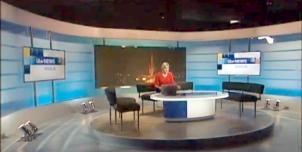Full Freeview on the Tacolneston (Norfolk, England) transmitter
| Google Streetview | Google map | Bing map | Google Earth | 52.518,1.139 or 52°31'6"N 1°8'22"E | NR16 1DW |
The symbol shows the location of the Tacolneston (Norfolk, England) transmitter which serves 330,000 homes. The bright green areas shown where the signal from this transmitter is strong, dark green areas are poorer signals. Those parts shown in yellow may have interference on the same frequency from other masts.
This transmitter has no current reported problems
The BBC and Digital UK report there are no faults or engineering work on the Tacolneston (Norfolk, England) transmitter._______
Digital television services are broadcast on a multiplexes (or Mux) where many stations occupy a single broadcast frequency, as shown below.
64QAM 8K 3/4 27.1Mb/s DVB-T MPEG2
DTG-12 QSPK 8K 3/4 8.0Mb/s DVB-T MPEG2
H/V: aerial position (horizontal or vertical)
Which Freeview channels does the Tacolneston transmitter broadcast?
If you have any kind of Freeview fault, follow this Freeview reset procedure first.Digital television services are broadcast on a multiplexes (or Mux) where many stations occupy a single broadcast frequency, as shown below.
64QAM 8K 3/4 27.1Mb/s DVB-T MPEG2
DTG-12 QSPK 8K 3/4 8.0Mb/s DVB-T MPEG2
H/V: aerial position (horizontal or vertical)
Which BBC and ITV regional news can I watch from the Tacolneston transmitter?

BBC Look East (East) 0.8m homes 3.2%
from Norwich NR2 1BH, 16km northeast (37°)
to BBC East region - 27 masts.
70% of BBC East (East) and BBC East (West) is shared output

ITV Anglia News 0.8m homes 3.2%
from NORWICH NR1 3JG, 16km northeast (38°)
to ITV Anglia (East) region - 26 masts.
All of lunch, weekend and 80% evening news is shared with Anglia (West)
Are there any self-help relays?
| Gt Yarmouth | Transposer | 1 km S town centre | 30 homes |
| Lowestoft (2) | Transposer | Rotterdam Rd | 125 homes |
How will the Tacolneston (Norfolk, England) transmission frequencies change over time?
| 1950s-80s | 1984-97 | 1997-98 | 1998-2011 | 2011-13 | 2013-18 | 2013-17 | 17 Jul 2018 | ||
| VHF | C/D E | C/D E | C/D E | E | E T | W T | W T | ||
| C3 | BBCtvwaves | ||||||||
| C31 | com7 | com7 | |||||||
| C32 | _local | ||||||||
| C37 | com8 | com8 | |||||||
| C39 | +ArqB | +ArqB | ArqB | ||||||
| C40 | BBCA | ||||||||
| C42 | SDN | SDN | SDN | SDN | |||||
| C43 | D3+4 | ||||||||
| C45 | ArqA | ArqA | ArqA | ArqA | |||||
| C46 | BBCB | ||||||||
| C50tv_off | BBCB | BBCB | |||||||
| C52tv_off | C5waves | C5waves | |||||||
| C55tv_off | BBC2waves | BBC2waves | BBC2waves | -BBCA | -BBCA | -BBCA | com7tv_off | ||
| C56tv_off | COM8tv_off | ||||||||
| C57tv_off | LNR | LNR | |||||||
| C59tv_off | ITVwaves | ITVwaves | ITVwaves | -D3+4 | -D3+4 | -D3+4 | |||
| C62 | BBC1waves | BBC1waves | BBC1waves | BBCB | |||||
| C65 | C4waves | C4waves | C4waves |
tv_off Being removed from Freeview (for 5G use) after November 2020 / June 2022 - more
Table shows multiplexes names see this article;
green background for transmission frequencies
Notes: + and - denote 166kHz offset; aerial group are shown as A B C/D E K W T
waves denotes analogue; digital switchover was 9 Nov 11 and 23 Nov 11.
How do the old analogue and currrent digital signal levels compare?
| Analogue 1-4 | 250kW | |
| SDN, ARQA, ARQB, BBCA, D3+4, BBCB | (-4dB) 100kW | |
| com7 | (-9.6dB) 27.4kW | |
| com8 | (-10.2dB) 24kW | |
| Mux 1*, Mux 2*, LNR | (-14dB) 10kW | |
| Mux A*, Mux B*, Mux C*, Mux D* | (-17dB) 5kW | |
| Analogue 5 | (-18dB) 4kW |
Local transmitter maps
Tacolneston Freeview Tacolneston DAB Tacolneston TV region BBC East Anglia (East micro region)Which companies have run the Channel 3 services in the Tacolneston transmitter area
|
|
Monday, 6 June 2016
M
MikeB11:53 PM
Tracey Sparkes: We need a postcode to find out what your problem is, but there is a high pressure system at the moment which is causing problems. And exactly the same thing used to happen to analogue, whatever people might chose to remember.
| link to this comment |
Tuesday, 7 June 2016
D
davidwf12:38 AM
Eye
Tonight again we have intermittently lost the HD channels......sig strength around 40-50% (normally 90) quality also down. IP23 8LP
| link to this comment |
davidwf's: mapD's Freeview map terrainD's terrain plot wavesD's frequency data D's Freeview Detailed Coverage
Friday, 10 June 2016
S
shirley cooper9:03 AM
Cromer
MikeB: like tracy sparks i too am fed up with having poor or no signal from tacolston mast. blaming the weather iis a very poor excuse and it it is time to do something. i suggest strenghening the signal but i suspect that isn't possible. i live near cromer and numerous complaints have been aired on streetlife. my postcode is NR27 0LB. thoroughly fed up and cannot find a complaint address for tacolston mast.
--------shiley cooper
| link to this comment |
shirley's: mapS's Freeview map terrainS's terrain plot wavesS's frequency data S's Freeview Detailed Coverage
C
Chris Stanforth10:01 AM
HIgh pressure weather conditions have always caused this problem for viewers on the east coast from time to time .Nothing to do with the change to digital. The power cannot be increased because that would cause interference to other countries . Now that all the same channels except Dave and Quest are on Freesat the best solution is to get a Freesat system which is not affected by high pressure weather.
| link to this comment |
R
Richard Cooper11:23 AM
Norwich
shirley cooper: Hi Shirley. Regretfully, you have been unable to learn from the many excellent comments made on the ukfree.tv website this week concerning weather conditions, all of which have been accurate, factually correct and certainly not 'an excuse' for a 'poor signal' or 'no signal' message on Freeview screens. Tacolneston is already running at a very high power, and, as you surmise in your post, cannot have its power increased any further. The Tacolneston mast is run by a company called Arqiva. Arqiva's telephone number is 01962 823434, should you wish to contact the company. It runs most of the transmitters in the country, but has to abide by Government and international agreements about transmitter powers. Hope this helps, Richard, Norwich.
| link to this comment |
Richard's: mapR's Freeview map terrainR's terrain plot wavesR's frequency data R's Freeview Detailed Coverage
M
Mary Macer4:32 PM
Bury St. Edmunds
I too was getting interruption of my Freeview signal (Bury St. Edmunds, IP33 2PE) recently and wondered whether it was related to high atmospheric pressure, as I do remember analogue signal problems in the summertime months years ago. However, when I looked at my barometer I didn't think that the reading was all that high, so went slightly into panic mode! When a friend of mind, who lives fairly close-by, reported similar problems I was reassured and things now seem to have improved, but I would agree that it was infuriating when in the middle of "Wallander" the picture disappeared and I "lost the plot". Nowadays many people do have catch-up, and as this happens infrequently I think we should all be glad that we do have a Freeview service which mostly serves us well. I hope the dissatisfied people are now back to happier days.
| link to this comment |
Mary's: mapM's Freeview map terrainM's terrain plot wavesM's frequency data M's Freeview Detailed Coverage
R
Richard Cooper5:11 PM
Norwich
Mary Macer: Well said, Mary (in your last post!). I must say I have had picture and sound break-up on PSB 2 (D3+4) multiplex when the pressure was only 1014 millibars, when standard atmospheric pressure is 1013.25 millibars, so the pressure doen't need to be much higher than normal for atmospheric conditions to start affecting tv reception. This surprised me as much as it seems to have surprised you. The pressure here in Norwich is currently 1013 millibars, so hopefully that's decreased enough for us not to experience any more break-up for a while! Richard.
| link to this comment |
Richard's: mapR's Freeview map terrainR's terrain plot wavesR's frequency data R's Freeview Detailed Coverage
MikeP
5:45 PM
5:45 PM
Mary (and Richard):
It is not just pressure that is relevant but the temperatures of the several layers of the atmosphere as well - which is why it's often referred to as a temperature inversion effect. The problem occurs at the boundary layer between lower warm air and higher cooler air and causes RF signals used for TV transmission to travel further than usual. That means it becomes possible for a more distant transmitter using the same frquency to interfere with your reception. That used to happen on the south coast when French signals caused problems, but that has largely been reduced by the adjustments made by the French authorities to the transmission patterns they use across northern France.
| link to this comment |
M
MikeB10:33 PM
shirley cooper: Talcneston is always problematic, because much of the coastal area has small hills which mask its signal. But looking at that postcode, you can see for yourself that supposed to be getting an excellent signal, and no, the signal strength is constant.
As other have already pointed out, if if you've got problem at the moment, its due to high pressure, which is both perfectly natural and beyond anyone's control. If you've got a problem long term, check your system.
| link to this comment |
Saturday, 2 July 2016
Select more comments
Your comment please!





